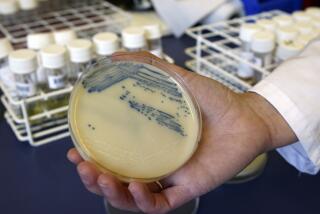Consortium Formed for Drug Research : S.D.-Based Group of 8 Firms Will Use Computers to Study Molecular Design
- Share via
Eight leading drug, chemical and computer companies have formed a San Diego-based consortium to conduct basic research into computer-aided molecular design programs.
The consortium could slash research costs and speed the development of new chemical and pharmaceutical products, said David H. Klipstein, president of Biosym Technologies, which has been organizing the group for a year. Biosym is a small, privately held San Diego-based company that develops molecular computer modeling tools for the chemical research industry.
In addition to Biosym, the consortium includes Abbott Laboratories, Cray Research, E.I. du Pont de Nemours, Monsanto, Merck Sharp & Dohme Research Laboratories, Rohm & Haas, and The Upjohn Co.
The consortium will use powerful computers to formulate mathematical models simulating chemical interactions that otherwise would have to be performed in time-consuming laboratory experiments, Klipstein said Monday.
The companies already had initiated their own molecular modeling programs, Klipstein said, but joined the San Diego consortium to speed basic research into the field, which is “crucial to the growth of the chemical and pharmaceutical industries.”
Molecular research is “just entering an era . . . where scientists can use computers to experiment with different variations and combinations,” said Klipstein.
“Although they’re not talking about a gigantic breakthrough or a new technology, it is very important to know exactly what the potential functions of molecules are,” said Robert Kraut, a chemistry professor at UC San Diego. He described the consortium’s research as “a refinement (of existing knowledge) that should have been done a long time ago.”
Consortium members hope to develop “accurate descriptions of how individual molecules act and how different molecules interact,” said Robert Fletterick, a professor of biochemistry at UC San Francisco.
“People in chemistry and biochemistry have long recognized that there’s been the need for a major effort at improving the programs that simulate and predict the properties of individual and collective molecules,” Fletterick said.
The three-year program will have a $250,000 budget during the first year, said Klipstein, who expects that the consortium will “grow during the next two years to become more of a significant thing.”
Biosym’s five-member research staff will be augmented by the research of individual consortium members. Research will be conducted on computers at Biosym, at member companies and at the Minneapolis headquarters of Cray Research, which builds supercomputers--ones that can process millions of bits of information quickly.
Biosym has been using existing but less sophisticated computer-generated simulations to develop its own line of molecular modeling programs, Klipstein said.
Consortium members, who are contributing both funding and staffers, will share in research findings. Biosym plans to add the new computer programs generated by the consortium to its line of molecular computer modeling tools.






